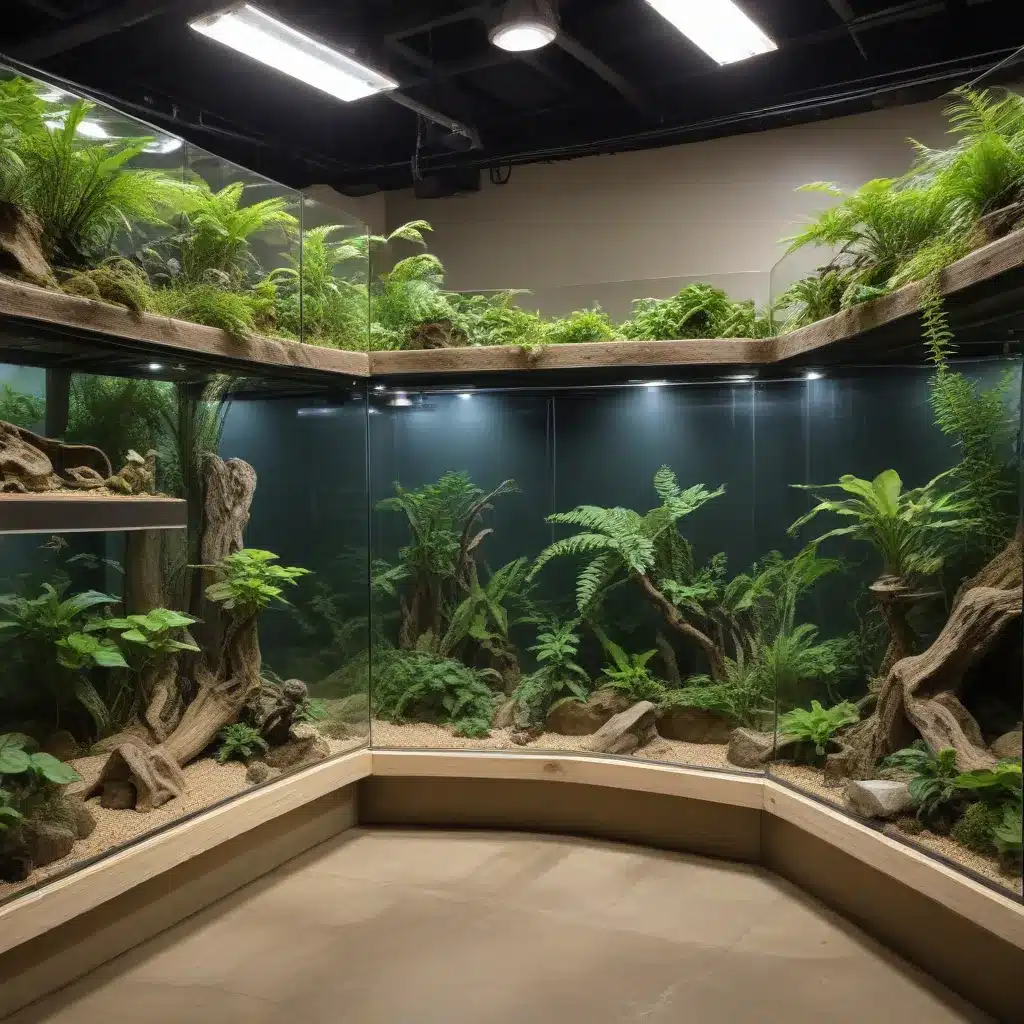
Understanding Reptile Habitat Requirements
Caring for exotic reptiles requires a deep understanding of their natural habitats and environmental needs. Each species has unique temperature, lighting, humidity, and substrate requirements that must be meticulously replicated in captive settings to ensure their health and well-being.
One of the crucial aspects of reptile habitat design is temperature regulation. Reptiles are ectothermic, meaning they rely on external sources to regulate their body temperature. Providing appropriate heating sources, such as heat mats, lamps, or cables, and using thermostats to maintain precise temperature ranges is essential. By creating distinct thermal gradients within the enclosure, reptiles can thermoregulate and engage in natural behaviors.
Lighting is another critical component of a thriving reptile habitat. Many reptile species require specific wavelengths of ultraviolet (UV) light to properly synthesize vitamin D3, which is essential for calcium absorption and overall health. Incorporating high-quality UV lighting fixtures and ensuring adequate exposure throughout the enclosure is crucial.
Humidity levels also play a vital role in reptile care. Maintaining the right balance of moisture is crucial for respiratory function, skin health, and proper shedding. Incorporating humidity-regulating elements, such as water features or misting systems, can help create the ideal microclimate for each species.
The substrate, or the material covering the floor of the enclosure, is another essential consideration. Choosing a naturalistic substrate that mimics the reptile’s native habitat can provide a suitable environment for burrowing, basking, and supporting the overall ecosystem. Natural substrates can also harbor beneficial microorganisms that contribute to the breakdown of organic matter and maintain a healthy pH balance.
Breeding Exotic Reptiles: Techniques and Considerations
Breeding exotic reptiles can be a rewarding and challenging endeavor. Successful breeding programs require a deep understanding of the species’ natural breeding behaviors, reproductive cycles, and environmental cues.
One of the key factors in reptile breeding is temperature manipulation. Many reptile species require specific temperature fluctuations to trigger mating and egg-laying. Carefully adjusting the enclosure’s temperature and lighting cycles can help simulate the natural seasonal changes that encourage breeding.
Nutrition is another critical aspect of reptile breeding. Providing a balanced, nutrient-rich diet that includes appropriate supplementation, such as calcium and vitamin D3, can support the animals’ overall health and reproductive success. Monitoring the female’s body condition and adjusting the diet accordingly can help ensure successful egg production and hatchling development.
Proper incubation and hatching techniques are also essential for reptile breeding. Maintaining the correct temperature, humidity, and air circulation within the incubator can significantly impact the hatchling’s survival and development. Closely monitoring the incubation process and intervening when necessary can help ensure a successful hatch.
Legal Considerations for Exotic Reptile Ownership and Sale
The ownership and sale of exotic reptiles are subject to various legal regulations, which can vary significantly depending on the species and location. It is crucial for reptile enthusiasts, breeders, and sellers to familiarize themselves with the relevant laws and requirements to ensure compliance.
In the United States, the regulation of exotic reptiles is primarily handled at the state and local levels. Some states may have specific permits or licenses required for the possession, breeding, or sale of certain reptile species. Additionally, the U.S. Fish and Wildlife Service oversees the import and export of protected species under the Convention on International Trade in Endangered Species of Wild Fauna and Flora (CITES).
Breeders and sellers of exotic reptiles must be aware of the legal requirements for record-keeping, providing health certificates, and adhering to transport regulations. Improper handling or documentation can result in significant fines and legal consequences.
It is essential for reptile enthusiasts and professionals to research the applicable laws and regulations in their area before acquiring, breeding, or selling exotic reptiles. Consulting with local authorities or industry organizations can help ensure compliance and responsible practices.
Ensuring Proper Reptile Health and Welfare
Maintaining the health and well-being of exotic reptiles is a top priority for responsible owners and breeders. Comprehensive veterinary care, preventive measures, and a proactive approach to monitoring the animals’ condition are key to ensuring their long-term vitality.
Regular check-ups with experienced reptile veterinarians are crucial for identifying and addressing any health concerns early on. These professionals can provide guidance on proper nutrition, parasite prevention, and the treatment of common reptile ailments, such as metabolic bone disease, respiratory infections, and gastrointestinal issues.
Proactive preventive care, including proper habitat setup, appropriate supplementation, and stress reduction, can go a long way in supporting the overall health and resilience of exotic reptiles. Monitoring the animals’ behavior, feeding patterns, and physical appearance can help owners and breeders detect potential problems before they escalate.
In the event of a health crisis, having a strong relationship with a qualified reptile veterinarian and being prepared with emergency supplies and protocols can make a significant difference in the animal’s recovery and long-term well-being.
By prioritizing reptile health and welfare, enthusiasts and professionals can ensure that their exotic reptiles thrive in captivity and contribute to the preservation and advancement of these fascinating creatures.
Conclusion
Crafting thriving habitats for exotic reptiles requires a deep understanding of their natural environments, comprehensive care practices, and a commitment to responsible ownership and breeding. By meticulously replicating the essential elements of temperature, lighting, humidity, and substrate, reptile enthusiasts and professionals can create environments that support the overall health and well-being of these captivating creatures.
Successful breeding programs, rooted in a thorough knowledge of reproductive cycles and environmental cues, can contribute to the conservation of rare and endangered species. However, navigating the legal landscape surrounding exotic reptile ownership and sales is crucial to ensure compliance and responsible practices.
Ultimately, the care and stewardship of exotic reptiles is a rewarding and challenging endeavor that demands a steadfast dedication to the animals’ welfare. By embracing best practices in habitat design, health management, and legal compliance, reptile enthusiasts can create vibrant, thriving communities of these fascinating creatures and foster a deeper appreciation for the diversity of the reptilian world.
Explore our selection of exotic reptiles for sale and discover the joys of responsible reptile keeping.

